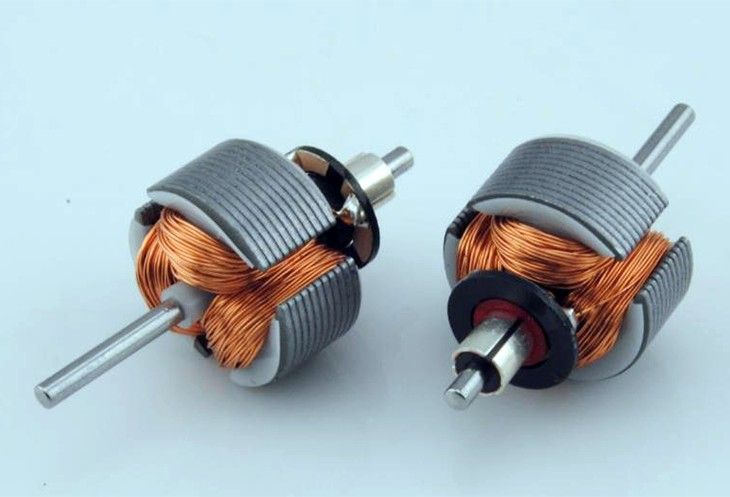بہتر حفاظتی برقی آلات میں, جیسے دھماکہ پروف موٹرز, ٹرانسفارمرز, برقی مقناطیسی تاریں, اور فلوروسینٹ لیمپ کے لیے بیلسٹس, ایک حصے میں اندرونی وائنڈنگز شامل ہیں۔. ان windings کے لئے ضروریات, میکانی اور برقی دونوں, معیاری windings کے لئے ان سے زیادہ ہیں.

عام طور پر, ان کنڈلیوں کو سمیٹنے کے لیے استعمال ہونے والی موصل تار کو ڈبل موصل ہونا چاہیے۔, اور کوائل کا ریٹیڈ قطر 0.25mm سے کم نہیں ہونا چاہیے۔.
ان کنڈلیوں کو سمیٹنے میں استعمال ہونے والے انامیلڈ تار کے لیے, GB/T6109.2-2008 استعمال کرنے کی سفارش کی جاتی ہے۔ “پالئیےسٹر اینامیلڈ گول کاپر وائر, کلاس 155،” GB/T 6109.5-2008 “پالئیےسٹر-امائڈ اینامیلڈ گول کاپر وائر, کلاس 180،” GB/T 6109.6-2008 “پولیمائیڈ اینامیلڈ گول کاپر وائر, کلاس 220،” یا GB/T6109.20-2008 “Polyamide-imide جامع پالئیےسٹر یا پالئیےسٹر-imide Enameled گول تانبے کی تار, کلاس 220۔”
اضافی طور پر, گریڈ 1 اینامیلڈ گول تانبے کی تار جیسا کہ ان معیارات میں بیان کیا گیا ہے استعمال کیا جا سکتا ہے۔, بشرطیکہ یہ معیارات میں بیان کردہ متعلقہ ٹیسٹ پاس کرے۔.
سمیٹنے کے بعد, وائنڈنگز کی موصلیت کی خصوصیات کو بڑھانے کے لیے ایک مناسب امپریگنیٹنگ ایجنٹ کا استعمال کیا جانا چاہیے۔.
حمل کے عمل کو کارخانہ دار کے مخصوص طریقہ پر عمل کرنا چاہیے۔, ڈپنگ جیسی تکنیک کا استعمال کرتے ہوئے, چلنا, یا ویکیوم پریشر امپریگنیشن (وی پی آئی) سمیٹنے والی تاروں کے درمیان خلا کو پُر کرنے اور مضبوط آسنجن کو یقینی بنانے کے لیے. اگر حاملہ کرنے والے ایجنٹ میں سالوینٹس ہوتے ہیں۔, سالوینٹس کے بخارات کی اجازت دینے کے لیے امپریشن اور خشک کرنے کا عمل دو بار کیا جانا چاہیے۔.
عام طور پر, انسولیٹنگ ونڈنگ کے لیے چھڑکاؤ یا کوٹنگ جیسے طریقوں کو ناقابل اعتبار سمجھا جاتا ہے۔ دھماکہ پروف برقی آلات. انجینئرنگ پریکٹس میں اس پر مناسب توجہ دی جانی چاہئے۔.
مزید, ہائی وولٹیج وائنڈنگز کے لیے, کورونا کے خارج ہونے والے اضافی خطرات کو روکنے کے لیے رنگدار ہوا کے ٹکڑوں کو اینٹی کورونا پینٹ سے ٹریٹ کیا جانا چاہیے.
بہتر حفاظتی برقی آلات میں, چاہے موٹرز, برقی مقناطیسی کنڈلی, یا دوسرے سامان کی کنڈلی, وہ عام طور پر لیس ہونا چاہئے درجہ حرارت عام آپریشن یا تسلیم شدہ غیر معمولی حالات میں حد سے زیادہ درجہ حرارت کو روکنے کے لیے حفاظتی آلات.
اگر ایک سمیٹ مسلسل اوورلوڈ کے تحت حد درجہ حرارت سے تجاوز نہیں کرتا ہے۔ (جیسے موٹر روٹر لاک), یا اگر سمیٹ اوورلوڈ کے تابع نہیں ہے۔ (فلوروسینٹ لیمپ کے لیے گٹی کی طرح), پھر اسے درجہ حرارت کے تحفظ کے آلے کی ضرورت نہیں ہے۔.
جب بہتر حفاظتی برقی آلات درجہ حرارت سے تحفظ کے آلات سے لیس ہوتے ہیں۔, یہ اندرونی یا بیرونی طور پر نصب کیا جا سکتا ہے. قطع نظر, حفاظتی آلہ مناسب ہونا چاہئے دھماکہ پروف قسم اور اس کا اندازہ محفوظ آلات کے ساتھ مل کر کیا جانا چاہیے۔.
 شینہائی دھماکہ پروف
شینہائی دھماکہ پروف
